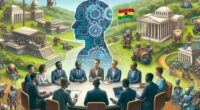Exploring the Frontier of TTS in Research Analysis: A Leap into Multisensory Data Interpretation
As the digital age forges ahead, the sheer magnitude and complexity of data available to researchers are at an all-time high. This plethora of information demands more than the traditional visual interpretation tools like graphs and charts. It beckons the advent of new, innovative methodologies to not just analyze but truly understand and utilize data to its fullest. Enter the realm of Text-to-Speech (TTS) technology – a turning point in multidisciplinary research that promises to redefine our interaction with data.
The incorporation of TTS technology into the analysis of research data is not merely an upgrade; it’s a revolutionary approach that leverages the human capability for multisensory perception. This means engaging both our visual and auditory senses, providing a richer, more holistic data interaction experience. Using TTS to convert data points into auditory output, researchers can detect patterns, anomalies, and correlations in ways previously unimaginable.
Imagine the complexity of vast datasets unraveled through sound, where every nuance and relationship within the data can be discerned audibly. This method can uncover insights that may remain hidden beneath the surface of traditional visual analysis, offering a fresh perspective that could lead to groundbreaking discoveries.
Another compelling advantage of TTS in research is its potential to significantly decrease cognitive overload. The intensive process of analyzing data visually can lead to fatigue, reducing a researcher’s effectiveness. By alternating between visual and auditory analysis, the strain on the eyes and the mind can be alleviated, leading to increased focus, productivity, and potentially more profound analytical insights.
Moreover, TTS technology opens doors to more inclusive, collaborative research environments. Through data sonification, which transforms data into non-speech audio signals, researchers around the globe can share findings effortlessly, transcending language and even discipline barriers. This auditory method of data representation is exceptionally beneficial in making data accessible to researchers with visual impairments, further democratizing the field of research.
However, integrating TTS into research practices is not without its hurdles. The precision of data sonification is paramount. Researchers must navigate the complexities of accurately scaling data, choosing the correct mapping strategies, and adhering to auditory perception principles to ensure the auditory data representations are not just innovative but also meaningful and interpretable.
There’s a learning curve for researchers accustomed to traditional methods, but overcoming this begins with interdisciplinary collaboration. The marriage of research, data science, and audio engineering expertise is critical in developing effective data sonification methods. Furthermore, dedicated educational programs can equip researchers with the skills to navigate and leverage TTS technology effectively.
As TTS technology continues to evolve, its integration with virtual and augmented reality platforms heralds a new era of data interaction. Picture a researcher immersed in a virtual environment, navigating through an auditory landscape that represents complex datasets. This represents a leap towards more immersive, multisensory research methodologies that could profoundly enhance data comprehension and exploration.
Yet, with great power comes great responsibility. The ethical considerations of implementing TTS in research cannot be overstated. Issues such as data privacy, consent, and the potential for bias in auditory representations must be addressed thoroughly. Establishing comprehensive ethical guidelines and best practices for TTS use in research is essential, ensuring that this powerful tool benefits the scientific community responsibly and equitably.
The journey to successfully integrating TTS into research is one that requires the collective effort of researchers, scientists, engineers, and ethicists from a myriad of fields. Through collaborative innovation and an ethical approach, TTS technology can unlock untapped potential in data analysis, fostering groundbreaking insights and advancing the frontiers of knowledge.









